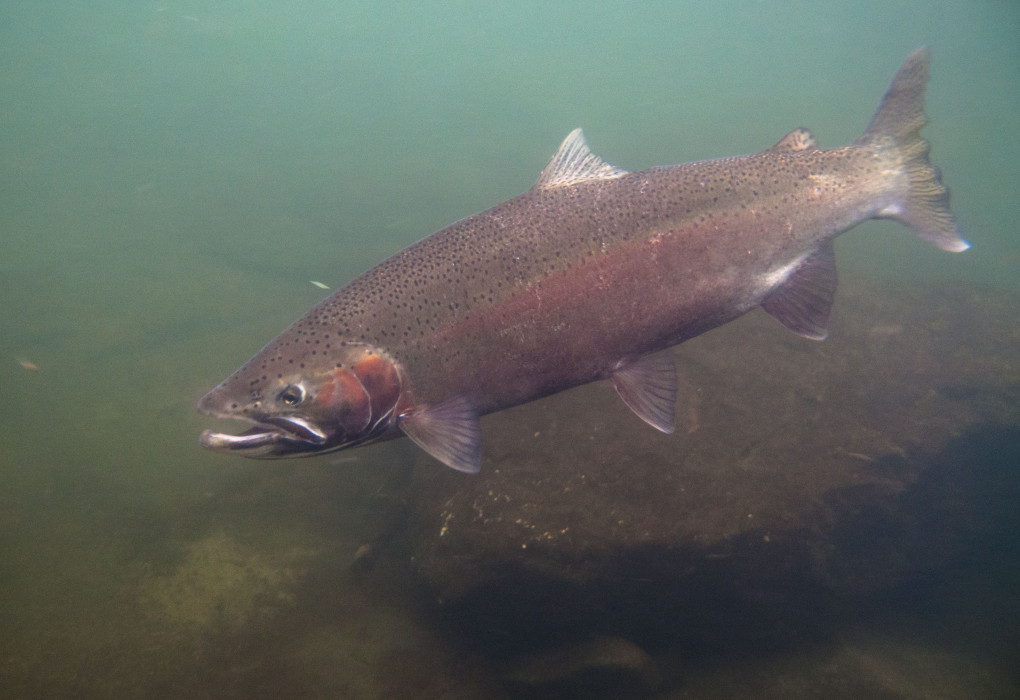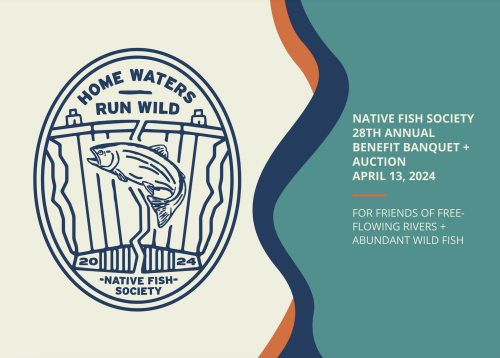Questions from Members: Wild Stock for Hatcheries?
Member Dave Kruse asked, "Another fish organization says they need to use wild stock for hatcheries. I’m not sure this is a good idea and would like your input." Dave’s question arose from a recent article in the Oregonian.
Thank you for the question Dave. We get a lot of questions about hatchery programs so I thought it would be helpful to put our answer up on the news and events page so that additional supporters could understand the issues with hatchery programs, specifically the use of wild stocks in hatchery programs or what hatchery managers call "integrated hatcheries."
First, a couple comments on terminology. Broodstock is a group of sexually mature adult fish that are bred together in a hatchery or aquaculture facility. The genetic makeup of the fish used as broodstock will determine the characteristics of their offspring. Wild, native fish are locally adapted, naturally spawning fish -- you know, good ol’ salmon or steelhead that return to their streams of origin to spawn after lives spent in the wild. Segregated broodstock hatchery programs use hatchery salmon and steelhead (identified by their clipped adipose fin) each year as broodstock for the next generation of hatchery fish. Hatchery fish making hatchery fish making hatchery fish. As a result of years of artificial breeding and rearing these fish survive poorly in the wild, return in a narrow timeframe, are generally similar in size, and, genetically, differ significantly from wild, native fish. Both anecdotally by anglers and as a result of scientific research, hatchery fish from segregated broodstock programs produce a poor sport fish and pose a laundry list of threats to wild populations.
In the broadest terms, hatchery fish negatively impact wild salmon and steelhead populations in four ways: The first and most commonly discussed way is through genetic impacts. When wild and hatchery fish spawn together, they produce offspring that are less capable of surviving and successfully reproducing in the wild. Salmon and steelhead raised in captivity adapt to their new digs and become domesticated (sort of like the difference between your dog and a wolf). When you breed a dog and wolf, you don’t get a wolf you get a hybrid -- same deal with hatchery and wild salmon and steelhead.
The second way hatchery fish impact wild fish is through ecological impacts, which include competition for food, space, predator attraction, and spreading disease.
The third way is through infrastructure impacts, which include hatchery facilities blocking spawning and rearing habitats, water diversions, effluent discharge (fish poop, antibiotics, cleaning chemicals), and mining wild populations by removing them from wild spawning populations for use in the hatchery program (more on this in a minute).
The fourth set of impacts are the indirect impacts, including the continued trade off of habitat degradation and hydropower development for hatchery programs, the opportunity cost of spending limited funds for salmon conservation on hatchery production, and creating mixed-stock fisheries where imperiled wild fish are killed in the process of catching hatchery fish.
As a result of the mounting issues with segregated broodstock hatchery programs, integrated broodstock programs, which use locally-sourced wild fish as broodstock, have emerged (or re-emerged as all hatchery programs started this way) to improve hatchery fish for anglers. According to their proponents, integrated broodstock programs also reduce the negative effects of hatchery fish on wild salmon and steelhead.
The benefits for anglers targeting hatchery fish, in particular steelhead from wild broodstock programs, are readily apparent in returning fish. Integrated broodstock derived hatchery fish are essentially "wilder" than fish from segregated hatchery programs. The incorporation of wild fish into the broodstock resulted in hatchery fish that were bigger and returned over a longer duration of the season, creating more angling opportunity. Hatchery managers and agencies appreciated the change because mixing wild stocks into the hatchery program resulted in a better hatchery fish for anglers. What isn’t clear, however, is if integrated broodstock programs provide any significant reduction in the negative impacts of hatchery fish on wild salmon and steelhead populations.
First, infrastructure impacts. Integrated broodstock hatchery programs rely on the same infrastructure as segregated programs. So, all the impacts listed above for segregated hatchery programs remain for integrated programs. Additionally, when wild steelhead are taken for broodstock, they are removed from the wild spawning population. They are foregoing their one and only opportunity to spawn naturally and contribute to the wild population's local adaptation and future returns. This is like stealing materials from the foundation of your house to build the second story. For the integrated broodstock hatchery program to work, it must have a substantial population of wild fish to draw from to keep the program going. But as the hatchery takes wild fish, it can increase the risks of reducing the abundance and genetic diversity of the wild population, undermining its own future.
Second, indirect impacts. Integrated broodstock hatchery programs share the same indirect impacts as segregated hatchery programs. They're as expensive, if not more expensive than their segregated counterparts, due to the additional challenge of collecting wild broodstock and transporting these fish the hatchery. They result in the same mixed-stock fisheries with both hatchery and wild fish being harvested together. The trade-offs between hatchery production, habitat degradation and hydropower development exist. Last, the opportunity costs for funding hatchery programs instead of other fish creating investments like habitat restoration continue with integrated as well as segregated broodstock programs.
Third, ecological impacts. Integrated broodstock hatchery programs contribute much of the same ecological impacts as segregated hatchery programs. Juvenile hatchery salmon and steelhead compete for food and space with wild fish and attract predators. Additionally, integrated broodstock hatchery programs may increase ecological impacts in a few life history stages, especially when it comes to steelhead. According to research by Stephen Hausch in his 2012 article, "Residualization of Hatchery Steelhead: A Meta-Analysis of Hatchery Practices" published in the North American Journal of Fisheries Management, integrated broodstock steelhead had higher rates of residualization (juveniles not going to the ocean) than hatchery steelhead of hatchery origin or segregated broodstocks. As a result, these juvenile hatchery steelhead stuck around the rivers competing for space and food with wild steelhead juveniles. Some of these residual hatchery fish mature sexually and spawn in the wild, further impacting the wild population. That of course leads to the final impact section.
Last, genetic impacts. According to research by Mark Christie in 2014,"On the Reproductive Success of Early-Generation Hatchery Fish in the Wild" published in the journal Evolutionary Applications, integrated broodstock hatchery programs did not result in hatchery fish that could match the survival and reproductive success of wild salmon and steelhead. "Our analyses clearly show that even hatcheries using local- and predominantly wild-origin broodstocks create fish with lower reproductive success than their wild-born counterparts." Christie's research looked not only at steelhead, but across a number of species and hatchery programs. "The reduced fitness of hatchery fish was consistently documented despite differences in geographic location, study species, hatchery practices, and analytical approaches." Christie's findings support earlier work, done in 2012 by Mark Chilcote. Titled "Reduced recruitment performance in natural populations of anadromous salmonids associated with hatchery-reared fish" and published in the Canadian Journal of Fisheries and Aquatic Sciences, Chilcote found that, "...the impact of hatchery fish from ‘wild type’ hatchery broodstocks was no less adverse than hatchery fish from traditional, domesticated broodstocks." Last, Mark Christie's 2016 research, "A single generation of domestication heritably alters the expression of hundreds of genes" published in the journal Nature Communications found that hatchery steelhead from integrated broodstock parents resulted in "...hundreds of genes that are differentially expressed (DE) between the offspring of wild fish (W × W) and of the offspring of hatchery fish (H × H) reared in a common environment." One generation removed from the wild, these hatchery steelhead from an integrated broodstock program displayed significant genetic changes that indicated their rapid adaptation to the hatchery environment. Moreover, these hatchery traits can be passed along to the wild population if integrated broodstock hatchery fish spawn naturally in rivers with wild fish.
In conclusion, the best available science indicates that integrated broodstock hatchery programs do not eliminate the genetic and ecological impacts of hatchery fish on wild populations.
As a result, the Native Fish Society works from the premise that the best hatchery is a healthy river. Our approach to hatchery reform is two-pronged. We actively support the increase of rivers without hatchery programs, like the system of eight Wild Steelhead Gene Bank rivers we’ve helped implement in Washington. Research indicates that the more separation in space that we can create between hatchery and wild fish the better. Second, we're working to identify and campaign to reform the most harmful hatchery programs. Our intent is to encourage managers to redirect funds currently allocated to hatchery production into efforts proven to increase the health, diversity, and abundance of wild, native fish. This includes habitat protection and restoration, dam and barrier removal, and increased fisheries monitoring and enforcement. Our Save Sandy Salmon campaign is an example of this work, focusing on an oversized hatchery program that jeopardized a huge public investment in wild salmon on Oregon's Sandy River.


